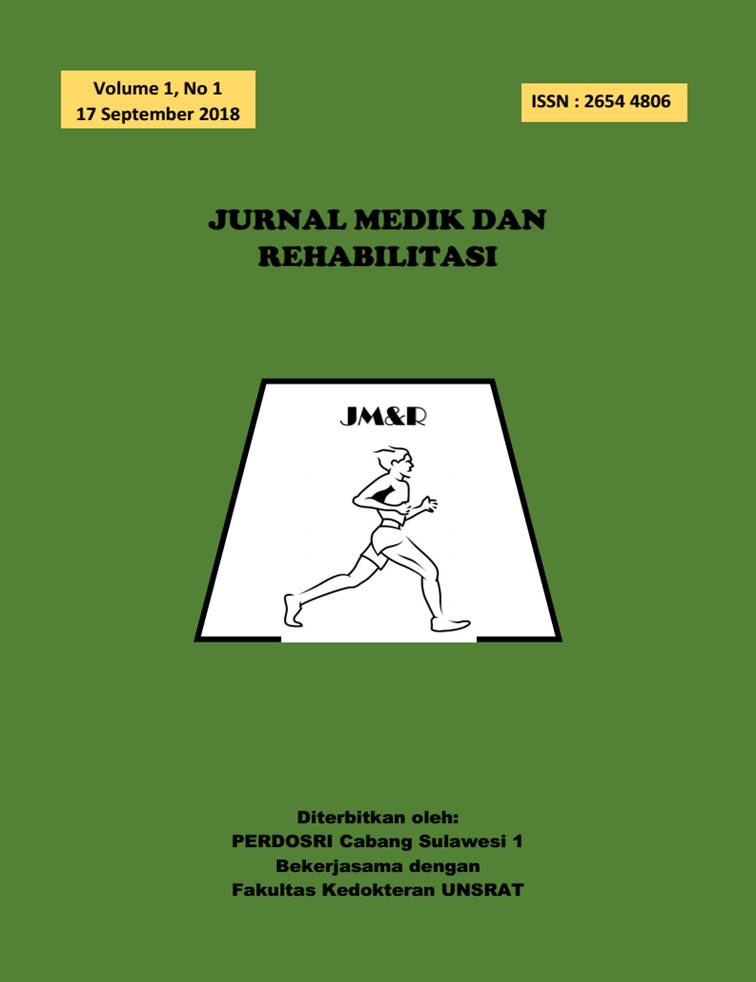REHABILITASI MEDIK PADA PASIEN DENGAN PLANTAR FASCIITIS KANAN
Abstract
Abstract
Most cases of inferior heel pain are diagnosed as plantar fasciitis. Although the clinical presentations vary, the most common patient types that are affected are the obese female over 40 years of age and the athletic runner. Both types commonly complain of experiencing heel pain (which can be intense), during the first few minutes of a weight bearing stance.1
Plantar fascitis is typically self-limiting with spontaneous resolution in more than 90% of cases by 1 year. Traditional treatment regimens are predominantly non operative. They involve patient education, ensuring correct footwear and anti-inflammatory drugs (both systemic and topical) with adequate analgesia. Rest and modification of daily activities in relation to weight bearing also need to be addressed along with other physical therapies.2
Treatment and rehabilitation began immediately. Patient was advised rest, icing and prescribed an anti-inflammatory medication if the pain come or worsening. He was taught a series of stretching exercises, targeting both the plantar fascia and Achilles tendon/triceps surae complex. A programme of strengthening to improve the load bearing capacity of the foot was shown. This consisted of strengthening Tibialis Posterior, the plantar-flexors of the ankle, the intrinsic muscles of the foot and the proximal hip musculature, including the hip abductors.3
 Keywords: Heel pain, plantar fascitis
Abstrak
Sebagian besar kasus nyeri tumit rendah didiagnosis sebagai plantar fasciitis. Meskipun presentasi klinis bervariasi, jenis pasien yang paling umum yang terkena adalah wanita gemuk berusia di atas 40 tahun dan atletik. Kedua jenis ini umumnya mengeluh mengalami nyeri tumit (yang bisa intens), selama beberapa menit pertama dari sikap menahan beban.1Plantar fascitis biasanya berakhir dengan resolusi spontan pada lebih dari 90% kasus selama 1 tahun. Rejimen pengobatan umumnya tidak operatif. Mereka melibatkan pendidikan pasien, memastikan alas kaki yang benar dan obat anti-inflamasi (baik sistemik dan topikal) dengan analgesia yang adekuat. Istirahat dan modifikasi kegiatan sehari-hari dalam kaitannya dengan beban berat juga perlu ditangani bersama dengan terapi fisik lainnya.2Perawatan dan rehabilitasi segera dimulai. Pasien disarankan beristirahat, icing dan meresepkan obat anti-inflamasi jika rasa sakit datang atau memburuk. Dia diajarkan serangkaian latihan peregangan, pada plantar fascia dan Achilles tendon / triceps surae complex. Sebuah program penguatan untuk meningkatkan kapasitas bantalan beban kaki ditunjukkan. Ini terdiri dari penguatan Tibialis Posterior, plantar-fleksor pergelangan kaki, otot-otot intrinsik kaki dan otot-otot panggul proksimal, termasuk abduktor pinggul.3
Kata kunci: Nyeri tumit, plantar fascitis
References
Roos C, Prousky J. Plantar Fasciitis: A Case Review. Journal of Orthomolecular Medicine. 2001: Vol. 16, No. 1
Hemaya S and Chadwic C. The Foot Chapter 14 in ABC of Common Soft Tissue Disorders. Oxford : John Wiley & Sons Ltd; 2016. P.84-85.
Cuccurulo SJ. Physical Medicine and Rehabilitation Board Review 3rd edition. New York: Demos Medical; 2015. P. 275-276.
Buchbinder, R., Plantar fasciitis. New England Journal of Medicine, 2004. 350(21): p. 2159- 2166.
Thomas J, Christensen J, Kravitz S,et al. The Diagnosis and Treatment of Heel Pain: A Clinical Practice Guideline–Revision 2010. The Journal of Foot & Ankle Surgery , 2010;S1–S19.
Lee, T.G. and T.S. Ahmad, Intralesional autologous blood injection compared to corticosteroid injection for treatment of chronic plantar fasciitis. A prospective, randomized, controlled trial. Foot & Ankle International, 2007. 28(9): p. 984-990.
McPoil, T., Heel Pain - Plantar fasciitis: Clinical Practice Guidelines linked to the International Classification of Functioning, Diability and Health from the Orthopaedic Section of the American Physical Therapy association J Orthop Sports Phys Ther, 2008. 38(4).
Wolgin, M., et al., Conservative Treatment Of Plantar Heel Pain - Long-Term Follow-Up. Foot & Ankle International, 1994. 15(3): p. 97-102.
DiGiovanni, B.F., et al. Tissue-specific plantar fascia-stretching exercise enhances outcomes in patients with chronic heel pain - A prospective, randomized study. Journal of Bone and Joint Surgery-American Volume, 2003. 85A(7): p. 1270-1277.
Bhogal G. Plantar fasciitis in a Professional Boxer: Clinical Case Report for ‘The Trevor Silver Memorial Essay Prize’. 2012 July.
Cameron MH. Physical agents in rehabilitation.4th edition.Missouri : Elsevier ; 2013. p.137-53; 195-99.

